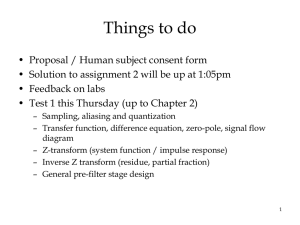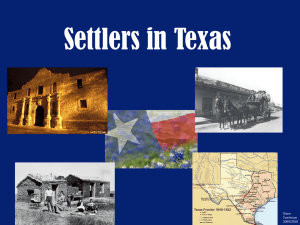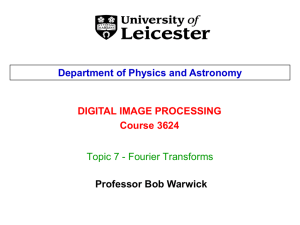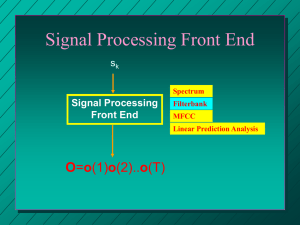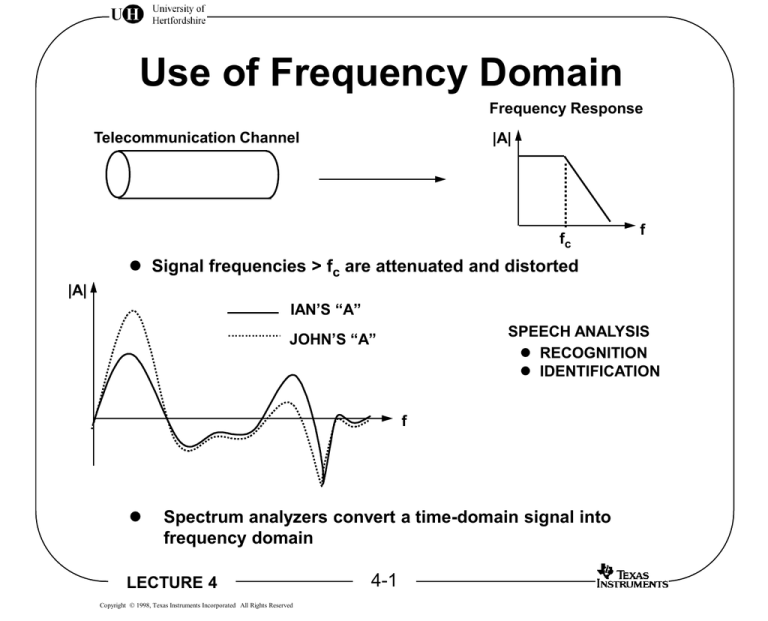
Use of Frequency Domain
Frequency Response
Telecommunication Channel
|A|
fc
f
Signal frequencies > fc are attenuated and distorted
|A|
IAN’S “A”
SPEECH ANALYSIS
RECOGNITION
IDENTIFICATION
JOHN’S “A”
f
Spectrum analyzers convert a time-domain signal into
frequency domain
LECTURE 4
Copyright 1998, Texas Instruments Incorporated All Rights Reserved
4-1
Fourier Series
Original Signal xp(t)
First 4 Terms of Fourier Series
Sum of First 4 Terms of
Fourier Series and xp(t)
Original xp(t)
Tp
First 4 Terms of Fourier Series
Periodic signal expressed as infinite sum of sinusoids.
xp (t )
ck
1
Tp
c e
k
jk 0 t
k
,
w here
x p ( t )e jk 0 t dt
Tp
Ck’s are frequency domain amplitude and phase representation
For the given value xp(t) (a square value), the sum of the first four terms of
trigonometric Fourier series are:
xp(t) 1.0 + sin(t) + sin(3t) + sin(5t)
LECTURE 4
Copyright 1998, Texas Instruments Incorporated All Rights Reserved
4-2
Fourier Transform
x(t) =
Ckej(k
k=-
Tp/2
0 t)
WHERE
Ck =
1
Tp
x(t) e-j(k0t) dt
-Tp/2
Increase TP = Period Increases
TP
No Repetition
1
Tp
x(t) e-j t dt
d / 2p
FT PAIR
C()
normalize
d
2p
C()
Discrete coefficients Ck become continuous
d
C() =
2p
2p
k 0
Discrete frequency variable becomes continuous
=
=
X()
=
x(t) e -jt dt
INVERSE
LECTURE 4
Copyright 1998, Texas Instruments Incorporated All Rights Reserved
4-3
x(t) =
1
2p
X() e
jt
d
Discrete Time Fourier Transform
Fourier Transform
x()
x(t )e
jt
Discrete Time
Fourier Transform
x()
dt
x(n)e
jn
n
Replace t with Tsn
Continuous x(t) becomes discrete x(n)
Sum rather than integrate all discrete samples
Inverse Fourier
Transform
Inverse Discrete Time
Fourier Transform
p
1
j( n )
x(n)
x
(
)
e
d
2p p
1
jt
x( t )
x
(
)
e
d
2p
Limits of integration need not go beyond ±p because the
spectrum repeats itself outside ±p (every 2p)
Keep integration because X() is continuous
LECTURE 4
Copyright 1998, Texas Instruments Incorporated All Rights Reserved
4-4
Discrete Fourier Transformation
Recall DTFT Pair:
X()
x (n) e
x(n)
jn
n
1
2p
X () e jn d
2p
There are an infinite number of time domain samples
is continuous
To Make DTFT Practical:
Take only N time domain samples
Sample the frequency domain, i.e. only evaluate x() at N discrete
points. The equal spacing between points is = 2p/N
The result is the Discrete Fourier Transform (DFT) pair:
N1
XN (k ) x(n)W
n 0
kn
N
and
w here WN e
LECTURE 4
Copyright 1998, Texas Instruments Incorporated All Rights Reserved
1 N1
x(n) XN (k )WNkn
N k 0
j
2p
N
Tw iddle Factor
4-5
DFT Relationships
Time Domain
Frequency Domain
|x(k)|
N Samples
N Samples
0
Ts
0
1
2Ts 3Ts (N-1)Ts
2
3
N-1
LECTURE 4
Copyright 1998, Texas Instruments Incorporated All Rights Reserved
X(n)
t
0
1
2
N/2
n
0
Fs
N
2Fs
N
Fs
2
4-6
N-2 N-1
k
2Fs
N
f
Fs
N
Practical Considerations
N1
Standard DFT
XN (k ) Xn (k )WNkn ,0 k N 1
n 0
An example of an 8 point DFT
7
Xn (k ) Xn (k )W 7kn , k 0,1,2,...,7
n 0
Writing this out for each value of n
Xn (k) x(0)W7k 0 x(1)W7k1 ....... x(7)W7k7,k 0,1,...,7
Each term such as
x(0)W7k 0 requires 8 multiplications
Total number of multiplications required: 8 * 8 = 64
Do not forget that each multiplication is complex
8-point DFT requires 8 2 = 64 multiplications
1000-point DFT requres 10002 = 1 million multiplications
And all of these need to be summed
LECTURE 4
Copyright 1998, Texas Instruments Incorporated All Rights Reserved
4-7
Fast Fourier Transformation
Symmetry Property
WNk N / 2 WNk
Periodicity Property
WNk N WNk
Splitting the DFT in two
or
Manipulating the twiddle factor
N
1
2
N
1
2
r 0
r 0
XN (k ) x(2r ).WN2rk x(2r 1).WN( 2r 1)k
N
1
2
N
1
2
r 0
r 0
XN (k ) x(2r ).(WN2 )rk WNk x(2r 1).(WN2 )rk
W e
2
N
j(
2p
2)
N
e
j(
2p
)
N/ 2
WN / 2
THE FAST FOURIER TRANSFORM
N
1
2
N
1
2
r 0
r 0
Xn (k ) x(2r )WNrk 2 WNk x(2r 1)WNrk 2
LECTURE 4
Copyright 1998, Texas Instruments Incorporated All Rights Reserved
4-8
Time Savings
N
1
2
N
1
2
r 0
r 0
xN (k) x(2r )WNrk/ 2 WNk x(2r 1)WNrk/ 2
(N/2) 2 Multiplications
(N/2) 2 Multiplications
N/2 Multiplications
For an 8-point FFT, 42 + 42 + 4 = 36 multiplications, saving 64 - 36 = 28
multiplications
For 1000 point FFT, 5002 + 5002 + 500 = 50,500 multiplications, saving
1,000,000 - 50,500 = 945,000 multiplications
Time savings assume 50ns cycle time
8-point FFT saves 1.2 ms
1000-point FFT saves 47.25ms
LECTURE 4
Copyright 1998, Texas Instruments Incorporated All Rights Reserved
4-9
Decimation in Time
Splitting the original series into two is called decimation in time
Let us take a short series where N = 8
Decimate once
Called Radix-2 since we divided by 2
n = {0, 1, 2, 3, 4, 5, 6, 7} n = { 0, 2, 4, 6 } and { 1, 3, 5, 7 }
Decimate again
n = { 0, 4 } { 2, 6 } { 1, 5 } and { 3, 7 }
The result is a savings of N2 – (N/2)log2N multiplications
1024 point DFT = 1,048,576 multiplications
1024 point FFT = 5120 multiplication
Decimation simplifies mathematics but there are more twiddle
factors to calculate
A practical FFT incorporates these extra factors into the algorithm
LECTURE 4
Copyright 1998, Texas Instruments Incorporated All Rights Reserved
4-10
4-Point FFT
3
Let us consider an example where N=4:
X4(k) =
kn
x(n) W4
0
1
Decimate in time into 2 series: X4(k) =
n = {0 , 2} and {1, 3}
r=0
rk
k
x(2r) W2 + W4
1
r=0
rk
x(2r+1) W2
k
k
k
= [ x(0) + x(2) W2 ] + W4 [ x(1) + x(3) W2 ]
REMEMBER:
We have two twiddle factors.
Can we relate them?
k
W2
Now our FFT becomes:
LECTURE 4
Copyright 1998, Texas Instruments Incorporated All Rights Reserved
k
WN = e
-j
2p
k
N
-j 2p * k
2k
-j 2p * 2k
=e 2
=e 4
= W4
2k
k
2k
= [ x(0) + x(2) W4 ] + W4 [ x(1) + x(3) W4 ]
4-11
Flow Diagram
Two DFTs:
2k
k
2k
X4(k) = [ x(0) + x(2) W4 ] + W4 [ x(1) + x(3) W4 ], k=0,1,2,3
Write out values for k=0 only:
0
0
0
X4(0) = [ x(0) + x(2) W4 ] + W4 [ x(1) + x(3) W4 ]
Represent with a flow diagram:
X4(0)
x(0)
0
x02
0
0
0 = W4
x(2)
x(1)
0
x13
x(3)
This is only one quarter of the flow diagram
LECTURE 4
Copyright 1998, Texas Instruments Incorporated All Rights Reserved
4-12
Full Flow Diagram
Write out all values for k:
0
0
0
= [ x(0) + x(2) W4 ] + W4 [ x(1) + x(3) W4 ]
2
1
NOTICE
2
= [ x(0) + x(2) W4 ] + W4 [ x(1) + x(3) W4 ]
6
-j 2p * 6
W4 = e
2
3
2
= [ x(0) + x(2) W4 ] + W4 [ x(1) + x(3) W4 ]
4
4
0
= 1 = W4
2
= -1 = W4
X4(0)
x(0)
0
0
2
1
x(1)
X4(1)
SPOT THE BUTTERFLY ?
2
X4(2)
3
X4(3)
0
x(3)
-j 2p * 4
W4 = e
0
2
0
= [ x(0) + x(2) W4 ] + W4 [ x(1) + x(3) W4 ]
x(2)
4
2
LECTURE 4
Copyright 1998, Texas Instruments Incorporated All Rights Reserved
4-13
The Butterfly
Twiddle Conversions
Typical Butterfly
x1
X1
k
X1 = x1 + WN x2
0
W4 = 1
1
W4 = -j
x2
k
WN
X2
k
X2 = x1 – WN x2
2
W4 = -1
3
W4 = j
4 Point FFT Butterfly
a
x0
4 Point FFT Equations
X0
0
X0 = (x0 + x2) + W4 (x1+x3)
1
x2
0
W4
x1
X1
X2
b
1
W4
x3
X3
LECTURE 4
Copyright 1998, Texas Instruments Incorporated All Rights Reserved
4-14
X1 = (x0 – x2) + W4 (x1–x3)
0
X2 = (x0 + x2) – W4 (x1+x3)
1
X3 = (x0 – x2) – W4 (x1–x3)
A Practical Example
Frequency Domain
Time Domain
Amplitude
Amplitude
2
2
1
1
0
0
1
2
3
Time
(nTs)
-5.0
2
NTs
2.5 5.0
1
2
Frequency
kHz
X0=x0+ x2 +x1+x3 = 1 + 0 + 0 + 1 = 2
SAMPLED AT 10kHz
Ts= 100 uS
F=
0
0
FFT Conversion
xk = {1,0,0,1}
1
-2.5
3
X1=x0–x2 + -j(x1–x3) = 1–0 + -j(0–1) = 1 + j
X2=(x0+ x2) – (x1+ x3) = (1 + 0) - (0 + 1) = 0
= Frequency Spacing
X3=(x0–x2)– -j (x1–x3) = (1–0)– -j(0–1) = 1– j
AMPLITUDE OF X1= 12+j2 = 2
LECTURE 4
Copyright 1998, Texas Instruments Incorporated All Rights Reserved
4-15
DSP and FFT
Fast Fourier Transform is a generic name for reducing DFT
computations. We considered Radix-2 here, but many other
algorithms exist.
The simplified butterflies can be implemented with a DSP
very efficiently
Special FFT chips implement it even faster
But DSPs are programmable
And they can perform other operations on the signal
FFT requires address shuffling for faster data table access
Most DSPs can perform shuffling in the background
Modern DSPs can perform an FFT of 1024 samples in well under 5 ms
LECTURE 4
Copyright 1998, Texas Instruments Incorporated All Rights Reserved
4-16
Summary
Frequency domain information for a signal is important for
processing
Sinusoids can be represented by phasors
Fourier series can be used to represent any periodic signal
Fourier transforms are used to transform signals
From time to frequency domain
From frequency to time domain
DFT allows transform operations on sampled signals
DFT computations can be sped up by splitting the original
series into two or more series
FFT offers considerable savings in computation time
DSPs can implement FFT efficiently
LECTURE 4
Copyright 1998, Texas Instruments Incorporated All Rights Reserved
4-17
Sliding Windows
Input signal sample
buffer
T
Original
windowed signal
T
T= 0
Figure 1
Figure 2
Subtract
old
New-old sample
window
Next windowed
signal
T
T=N
Figure 3
T= 0
Add new value
T
Figure 4
Window is time shifted
by one sample
LECTURE 4
Copyright 1998, Texas Instruments Incorporated All Rights Reserved
4-18
Example Frequency Bin
New Sample
x[0]
Old Sample
x[N-1] x K2
N Delay
K2 = K1N
-
Note: K1=0.999
Further
Frequency
Bins
+
K1 x
K1 x (X[k]*ej2pn/N)
ej2pn/N
X[k]
LECTURE 4
Copyright 1998, Texas Instruments Incorporated All Rights Reserved
4-19
The Phasor Model
COMPLEX
PLANE
Im = Imaginary
Re = Real
Im
A
b
PHASOR = VECTOR ROTATING
f
Speed = rad per second
Amplitude = A
Re
a
1. Rectangular Form
x(t) = a + jb
A=
a2 +
b2
x(t) = Ae j(t) where
j = -1
where
and
2. Polar Form
f = t = tan -1
b
a
e j(t) = cos(t) + j sin(t)
= 2pf
p = 180 degrees
LECTURE 4
Copyright 1998, Texas Instruments Incorporated All Rights Reserved
4-20
Modeling Sinusoids
REWRITE: e
jt
AS e
LET
AND
j(f ) = cos(f ) + jsin(f )
f ( t + a) OR (nTs + a)
cos f =
AND e
THEN
- j(f ) = cos(f ) - jsin(f )
sin f =
e j(f )- e - j(f )
2j
e j(f )+ e - j(f )
2
Drawing the phasors for cos f
Im
R/2
b
In general:
x(t) = R cos(t + a )
f
A
a
x(t) = R cos(t + a )
j(t + a )
- j(t + a )
R
(e
+e
)
x(t) =
2
-b
R/2
LECTURE 4
Copyright 1998, Texas Instruments Incorporated All Rights Reserved
Or as a sum of two phasors:
4-21


![Y = fft(X,[],dim)](http://s2.studylib.net/store/data/005622160_1-94f855ed1d4c2b37a06b2fec2180cc58-300x300.png)
